
 topics
topics
 download media
download media
 search
search
| 1500 - 1847 | 1848 - 1919 | 1920 - 1959 | 1960 - 1999 | 2000 - 2020 |
Pre-European Contact & Spanish California 1500 - 1847





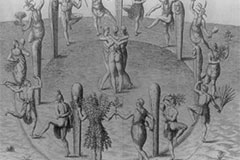

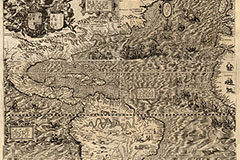

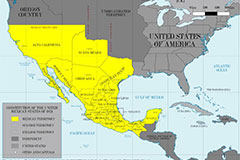

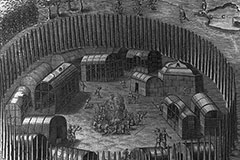

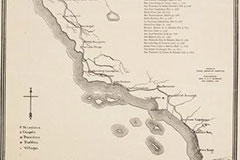




What would you like to find?

Downloadable Media: Pre-European Contact &Amp; Spanish California
Imagery







According to archaeological remains, evidence of human life in the area that is now known as California dates back to at least 19,000 years ago. Based on population estimates, approximately one-third of all Native Americans in the lands that are now the United States lived in California, taking advantage of the temperate climate and abundance of natural resources.
Klein, Barry T. Reference Encyclopedia of the American Indian. 7th ed. West Nyack, NY: Todd Publications, 1995

Natural Resources Abound, pre-European Contact
California’s native plant life was abundant and specific—about 1/3 of the state’s native plant species were endemic, meaning that they are native only to the state. California was also the home to a wide variety of native animal species, including the grizzly bear, tule elk, pronghorn antelope, black jaguar (now extinct), bighorn sheep, river otters, mink, and beavers. The rivers were full of fish, especially salmon. The marshlands across the state supported huge populations of mammals and birds, especially waterfowl (geese and other species).
Questions
What are some present-day examples of plant and animal species that are not native to California?
What happens to native species when non-native ("exotic") species are introduced?
Anderson, K. (2005). Tending the Wild: Native American Knowledge and the Management of California's Natural Resources. Berkeley, University of California Press.
Native Americans before European contact lived in small tribal groupings, often with individual languages, cultural practices, and agricultural techniques.

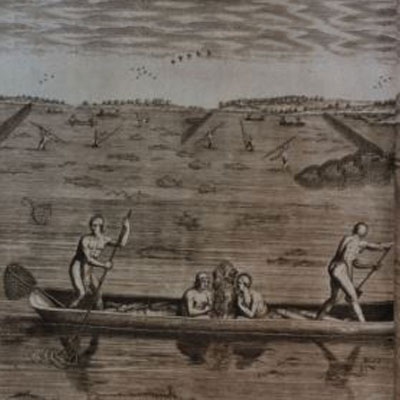
Specifics of Tribal Life
While it is easy to categorize the early Native Americans into one large group, the reality is that each tribe had its own customs, territories, and lifestyles.
For example, the Pomo tribe in Central California was most well-known for its basket weaving processes. Baskets made by Pomo Indians were elaborate and beautiful. Despite the intentional suppression of Native American cultural practices and types of art, basket weaving survived throughout the centuries and basket weavers continue the practice today.
In Southern California, the Chumash living on the Channel Islands traveled back and forth between the mainland of the state and the islands in canoes called “Tomols” that could carry hundreds of pounds of goods and several passengers.
Northwestern tribes along the Pacific Ocean enjoyed the benefits of their location and were comparatively wealthy. The redwood trees in the region were used for building houses and canoes. The Europeans believed that all tribes practiced fully communal living, and that there was no private ownership of food or property. However, many northwestern tribes practiced private ownership; tribal leaders owned property such as tree groves and fishing areas along rivers and creeks.
In addition to these specific examples of culture and lifestyle, each tribe had different ways of gathering and growing food for their people. Between forest gardening, hunting and gathering, fishing, small population sizes and specialization of roles/jobs, most Native societies were self-sufficient and could have continued successfully for centuries.
Questions
How did Native American tribes sustain themselves?
What made them self-sufficient?
Dr. Edward D. Castillo, "California Indian History" from Native American Heritage Commission

Native American Tools and Techniques
Native American tools, while rudimentary by today’s standards, revolutionized life. Today, visitors to Yosemite National Park can view ‘pounding rocks’ that feature shallow mortar holes created by Native Americans for grinding acorns into the stone with a smaller rock. The grinding process reduced the acorn-nut meat down into a coarse meal, which was then sifted and pounded again. Once the desired amount of acorn flour was produced, the flour was mixed with water to create a dough, which was then boiled using red-hot stones to produce various flour-based foods. This is one of many processes that represented early agricultural and food production practices developed by Native Americans.
Tribes utilized the large variety of plant and animal resources by following a pattern of population movements that was closely related to the seasonal availability and life cycles of specific species. Because of the abundant plant and animal life available, Native Americans did not need to produce large amounts of agriculture; instead, the majority of tribes were hunter-gatherers. However, many tribes did develop techniques for small-scale agricultural production.
Native Americans tended the land using a wide variety of techniques including controlled burning, weeding, pruning, tilling, irrigation, and replanting. Controlled burning was likely developed as tribes observed the impacts of natural fires on land over time. The cumulative effects of both natural and purposefully set fires, in addition to small-scale agricultural practices, created the Californian landscape that European explorers would find in the 16th century. When European explorers arrived in California, they did not understand that Native Americans used fire to intentionally change ecosystems.
Questions
Currently, California experiences frequent forest fires. Could traditional methods of controlled burning, first used by Native Americans, benefit us now?
Why are these methods not used currently?
What are the potential issues of controlled burns?
Williams, G. "References on the American Indian Use of Fire in Ecosystems" - Report for USDA Forest Service ; Before 1768: Pre-Columbian California curated by University of California, available under a CC BY 4.0 license. 2011, Regents of the University of California. ; Dr. Edward D. Castillo, "California Indian History" from Native American Heritage Commission

Trade Between Native American Groups
Based on archaeological evidence and oral traditions, historians believe that Native Americans transported food, medicine, raw materials, and cultural tradition across what is now Yosemite National Park. For example, various tribes native to Yosemite National Park traded acorns for salt, obsidian (used for arrowheads), and pine nuts.
Many well-used trade routes, such the route over Pacheco Pass that links the Salinas and San Joaquin Valleys, later became horse trails, wagon roads, and eventually the path for railroad tracks linking various regions of California.
Questions
What geographic areas did early Native American groups concentrate in?
What resources are native to those areas?
National Parks Service
The first European explorers reached California by sea in 1542.


Juan Rodriguez Cabrillo makes a claim for Spain, 1542
On September 28, 1542, explorer Juan Rodriguez Cabrillo and his expeditionary forces landed in what is now known as the San Diego Bay. Originally, Cabrillo’s expedition was attempting to locate the Strait of Anian, an all-water path across North America (that does not exist).
Cabrillo’s discovery of what would become known as California gave Spanish captains a stopping point during the trade route between the Philippines and Spanish Mexico where they could resupply and make repairs if needed. By 1585, there were multiple ships traveling back and forth between the two Spanish landholdings.
The transit between the Philippines and Spanish Mexico, and the mid-point port in California, were the first potential instances of the accidental spread of seeds to the shores of California.
Questions
What were the Spanish shipping back and forth from the Philippines and Mexico?
What new species of plant and animal were likely introduced to California as a result of this trade route?
"Juan Rodriguez Cabrillo"; "Cabrillo National Monument," National Parks Service

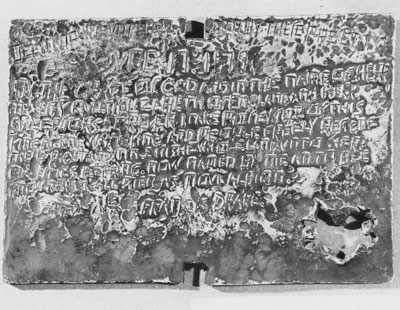
Additional Explorers
Sir Francis Drake landed in Northern California in 1579 to make repairs to his ship and claimed territory near present-day San Francisco Bay for the English crown, naming it Nova Albion. In 1595, Sebastian Rodriguez Cermeito anchored unexpectedly in California. Seven years later, Sebastian Vizcaino arrived with his expedition in California. Small numbers of Spanish explorers continued traveling to California.
However, because traveling to Alta (Upper) California was difficult at best and deadly at worst, the Spanish did not attempt to control Alta California until almost 150 years later, in the 1760s. Native Americans continued to practice hunting and gathering and small-scale agriculture methods to sustain their small tribes, and the few Spanish explorers that reached California impacted agriculture very little overall.
Questions
Why did Sir Francis Drake, and other non-Spanish explorers, choose not to settle and colonize California?
What were the challenges of colonization?
"Early California: pre-1976-1840s: Early Explorers," California Perspectives on American History http://picturethis.museumca.org/timeline/early-california-pre-1769-1840s/early-explorers/info
In the 1760s, the Spanish began to seek control of the land they had claimed more than 100 years previously in Alta California. A combination of military forts, called presidios, and religious communities, called missions, would be set up across California. The first mission was established in modern-day San Diego and was called Mission San Diego de Alcala.

The Mission System
Between 1976 and 1823, twenty additional missions would be established, in addition to satellite presidios (military forts), pueblos (towns and villages), and ranchos (farms and ranches).
These missions were used as a central point for gathering small groups of Native Americans together in a central location. The goal of Spanish priests and explorers was to convert the Natives, who they perceived as uncivilized, to good Spanish citizens. To do this, the Native Americans were taught Christianity and civilized skills including textile weaving, farming, processing grains, sheep shearing, and wine making.
Some natives were willing to learn the new ideas and skills that the Spanish brought with them, while others chose to work with the Spanish for the benefits of food and security. As the mission system expanded, the economic structure of Spanish California and changing environment made it difficult and at times impossible for Indians to continue their traditional lifestyles. An exchange of information took place in missions; Natives learned Spanish practices, while Spanish priests learned how to use plants endemic to California for food and medicine.
To learn more about missions and their impact, visit calindianmissions.org and californiamissionguide.com
Questions
What was the intention behind establishing the network of missions across California?
What types of economic benefits did the missions provide to the Spanish empire?
Anderson, K. (2005). Tending the Wild: Native American Knowledge and the Management of California's Natural Resources. Berkeley, University of California Press.

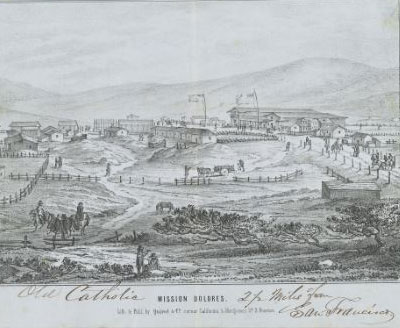
Agriculture in Missions
The twenty-one missions encompassed thousands of acres of farmland, grazing lands, vineyards, orchards, and gardens. Between the fields and the herds of cattle and sheep, mission lands became significant sources of income for the Spanish, netting $10,000 - $50,000 annually.
By 1832, the California missions were home to over 420,000 head of cattle and an additional 320,000 sheep, goats, mules, hogs, and horses. Cattle ranching was especially important, as the beef produced fed the Native population and the hides, once processed, could be sold or traded.
Spanish priests and settlers planted cuttings and seeds of European plants in order to grow food, medicine, and ornamental plants. The majority of fruit trees now commonly grown in California, including some varieties of apples, oranges, lemons, and olives, were imported by the Spanish, either from Spain or from New Spain (Mexico). Every mission also produced grapes to make wine. Some missions diversified and grew exotic crops including coconuts, figs, and sugar cane, if conditions were suitable.
Non-native plants spread to wildlands and competed with native plant life. The large numbers of livestock in combination with non-sustainable practices damaged native plant species, increased the propagation of invasive species, and caused erosion. Without modern scientific advancements, there was no way to know that the practices being used would cause long-term damage to California’s landscape.
Questions
What types of agricultural products came from mission lands?
How did the Native Americans living in missions aid in agricultural production?
What were some of the negative outcomes of the agricultural system in the missions?
missionscalifornia.com ; Doti, L. (2019). "Spanish California Missions: An Economic Success" Economics Faculty Articles and Research.
The Mexican War of Independence formally began in 1810. While Alta California was not directly impacted by the warfare taking place in Mexico and Baja (Lower) California, the War did result in the closing of the shipping port of San Blas, near modern-day Panama. This closure stopped the flow of goods and arrival of missionary priests to Alta California for a decade. This closure meant that the missions had to become fully self-sufficient and agriculture production became the main focus of priests, Spanish citizens, and Native Americans.
When the war ended in 1821, Mexico was officially an independent country. However, the war had major repercussions for the Native American population. A combination of epidemics (including smallpox, measles, and pneumonia) in conjunction with minor armed conflicts between Mexican citizens and Native Americans and the associated destruction and delay of food supplies decimated the population of the state. The estimated population of Native Americans decreased from approximately 245,000 to 150,000.
Anderson, K. (2005). Tending the Wild: Native American Knowledge and the Management of California's Natural Resources. Berkeley, University of California Press.

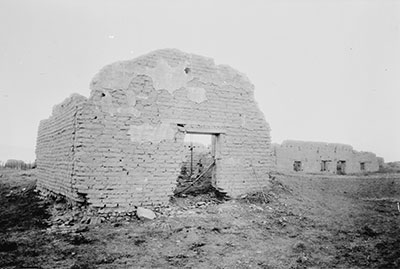
Secularization of California
Between 1834 and 1836, the Mexican government revoked the power of Spanish priests and reclaimed California’s mission lands before redistributing them to soldiers and farmers. Although originally intended as a fair process to distribute land to both Mexican citizens and Native Americans, most Indians were either put to work on ranchos or went to live elsewhere.
By 1846, more than 500 ranchos existed across Alta California. Rancheros (owners of ranchos) used Indian laborers in a peonage system to exchange homes, food, and other goods for labor instead of formal payment.
Questions
What happened to the physical land and buildings that housed the missions?
What happened to the Native American residents of mission lands?
Duran, N. (nd.) "Secularization of the Missions" from digitalhistory.uh.edu
Although California would not be admitted to the union to become the 31st state until 1850, it was a popular destination for world travelers, and became increasingly popular for pioneers from the East Coast as well. Listed below are some notable settlers that contributed to California's agricultural power.

John Bidwell
John Bidwell was born in 1819 in New York and became one of the first emigrants on the California Trail in 1841 as a 22 year old. Bidwell traveled around California, eventually purchasing Rancho Arroyo Chico, over 22,000 acres of fertile soil. By 1860, Bidwell’s cattle herd had over 1,300 head, and he invested in sheep during the Civil War. Bidwell also cultivated wheat, earning a gold medal at the 1878 Paris International Exhibition for the finest wheat in the world. In addition to planting almond and walnut orchards, Bidwell introduced and experimented with new species of melon and corn. He donated his land for Chico Normal School, which would later become CSU Chico. After Bidwell’s death in 1900, his widow donated almost 2,000 acres of the estate to become Bidwell State Park.
Questions
What else is John Bidwell known for?
Michael J. Gillis and Michael F. Magliari, John Bidwell and California: The Life & Writings of a Pioneer 1841-1900 (Spokane: Arthur H. Clark Company, 2004). https://bidwellmansionpark.com/history/bidwell-mansion-timeline/

Agoston Haraszthy
Agoston Haraszthy was a Hungarian immigrant who traveled to California before the Gold Rush, arriving in 1840. After forming a partnership with Spanish-Californian Juan Bandini and settling in San Diego, Haraszthy launched several agricultural businesses including fruit orchards, a stable and stagecoach line, and a butcher shop. He ordered grape vines from the eastern U.S. and from Europe. After some political involvement, including sheriff of San Diego County, San Diego city marshal, a term on the California State Assembly, Haraszthy moved to Sonoma and purchased a small vineyard.
Haraszthy’s techniques included hillside plantings without irrigation, and he advocated for Chinese immigration in order to increase the availability of labor. In 1858, Haraszthy wrote a “Report on Grapes and Wine of California,” published by the California State Agricultural Society, offering advice for planting vines and making wines. He became president of the California State Agricultural Society in 1862.
Haraszthy moved to Nicaragua in 1868 and disappeared in 1869.
Questions
What were Haraszthy's new techniques and advice for winemakers?
Agoston Haraszthy, "Report on Grapes and Wines of California", Transactions of the California State Agricultural Society for the Year 1858, Sacramento: 1859 McGinty, Brian. Haraszthy at the Mint. Los Angeles: Dawsons Book Shop, 1975. McGinty, Brian. Strong Wine: The Life and Legend of Agoston Haraszthy. Stanford University Press, 1998. ISBN 978-0-8047-3145-4


